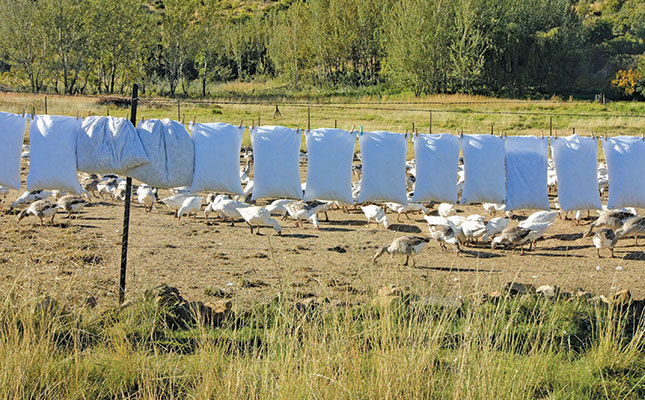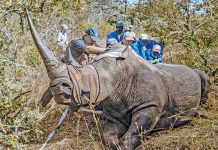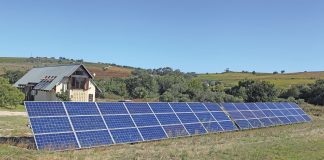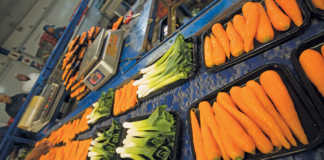
Photo: Annelie Coleman
About 12 years ago, Anton and Sharon Kock resigned from their jobs in the banking sector and bought the farm Schoonzicht, near Ficksburg in the Eastern Free State.
“We wanted to escape the rat race,” admits Anton.
But their life in the country has been no idle affair. In the intervening years they have built up a successful goose down and feather production business that has become the economic backbone of the farm.
“From the outset, our mission was to add as much value as possible, and not allow our primary product to leave the farm gate without increasing its worth. And that’s how Ember Down came about.”
Sharon, who grew up on a dairy farm in the Heidelberg district, credits her grandmother with the idea of their business. ‘Granny Lloyd’, as she was known, made duvets and pillows from goose down and feathers. Drawing on this background, and with an interest in geese as a driving force, Sharon started Ember Down shortly after she and Anton settled on the farm.
Rounding up the flock
The down is the layer of fine feathers found under the tougher exterior feathers, and very young birds are clad only in down, explains Sharon. It is an exceptional thermal insulator and padding material, used in products such as jackets, bedding, pillows and sleeping bags.
The Kocks only use pure down and down feathers, and never cut up the larger feathers to bulk out their products.
They started by buying all the geese they could lay their hands on within a radius of about 400km around Ficksburg, a task that saw Anton traversing the Free State and North West.
“We weren’t picky, and bought virtually all the birds we could get. We use both white and grey down, but don’t mix the two colours,” says Anton.
The geese flocks were initially kept on the farm, but predation by black-backed jackal, caracal and mongoose posed a nearly insurmountable problem.
The jackal and caracal preyed on the geese, while the mongoose feasted on the eggs and attacked goslings. The pressure from predation became so severe that the couple decided to move the flocks to safer havens in Gauteng, at locations they prefer not to divulge.
A caring approach
Humane and ethical management forms one of the pillars of the company; Anton and Sharon are passionate about their birds.
“They are, after all, the core of our business. We do everything in our power to ensure they live a good life. We do not tolerate any cruelty to any of our animals, including our Dormer sheep, the four donkeys, the Dexter cattle, the six dogs, the fish or any of our wild animals, including the predators,” Anton says.
The geese sleep in pens that allow 0,5m2 to 1m2 per bird, and have ready access to sufficient dams, shade and cover to enable them to build secluded nests with dry grass as well as down and feathers.
They spend most of their time wandering around the grazing camps by day, and are fed supplementary feed at night.
Feed and fibres
The feed rations include maize and lucerne pellets. A high protein content in the feed is essential for ensuring top-quality fibre development. Without enough protein, the fibres become brittle, resulting in poor-quality down and feathers.
The average Ember Down yield is 20g of down per goose. According to Sharon, a king-size winter duvet contains the down of about 70 geese.
Down and feathers are also sourced from other producers as far afield as Smithfield, the Swartland, Senekal and Koffiefontein. The Kocks are always on the lookout for suppliers of good-quality down and feathers.
The birds are plucked twice annually, when they moult. During this eight- to 10-week flightless period, they shed their outer wing feathers and regrow new ones. The feathers ripen over this period, enabling easier plucking, and the birds are not harmed in the process. This allows them to build up reserves for winter.
According to Anton, it is crucial not to disturb the geese during breeding in July, August, September and October. This is why sufficient cover for the birds to build quiet and sheltered nests is so important.
Geese lay between 10 and 25 eggs each season. The goslings arrive after about 28 days, and the parents become fierce guardians.
A parental group can vary from a gander-goose breeding pair to up to four ganders assisting one goose, he explains. Geese are monogamous in the wild, but become polygamous in captivity.
The goslings imprint on the mother from day one, and follow her wherever she goes. The goose and goslings develop a soft tweet language, which she uses to call them, and they maintain communication during the day by emitting soft, continual squeaks.
Goslings rarely stray further than 1,5m to 2m from their mothers, while the ganders form a rough, protective perimeter between the goslings and any approaching danger.
Goslings remain attached to their mothers throughout their lives.
“Most of our first hatched geese are still alive, 12 years now. The records say geese can live up to 20 to 25 years,” says Sharon.
With such healthy, plump bodies, she says she can believe that.
Flagship product
Cleaning and preparing the down and feathers for use in the final product is an intricate affair, as they are washed with special soaps, treated, and sterilised on the farm.
Drying takes place in sunlight, and can take up to three weeks. By means of the sun’s UV rays, a filling that is machine-washable, hypoallergenic and mite-resistant is achieved.
Clean goose down is an international commodity, and good-quality goose down is judged by its fill power. This is measured by the number of cubic centimetres that can be filled by each gram of down.
The Ember Down goose down duvets are the flagship of the business.
The Kocks admit that it took perseverance to get the business where it is today. During the first month after production started, only one baby-cot duvet was sold, recalls Sharon.
“Anton was sceptical about the business initially. But we’ve succeeded in making our mark over time, and nowadays our product range consists of a variety of duvets and pillows, as well as a clothing range.
“We realised early on that the fabric used in the manufacturing process was crucial.”
Anton went to a great deal of trouble to find a fabric manufacturer that could weave fabric to their specifications. They required a 400-thread count, 100% down-proof cotton, and eventually found a manufacturer in the Far East. They visit the plant regularly to inspect the rolls of fabric for thread count, weave integrity, and the cotton used.
The Kocks employ 21 women at the factory on the farm. Top workmanship is required from all staff members, and the couple maintain a ‘zero tolerance’ policy in terms of quality.
They appreciate the role their employees play, and have invested heavily in improving their lives.
“Happy employees are more productive,” says Sharon.
“Initially, we only employed single mothers. We now employ anyone who has the aptitude to work for Ember Down, and who meets our rigorous criteria.”
Sales and marketing
Anton and Sharon say that much of their business is word of mouth. They market their products online and in retail shops in Clarence and Clocolan.
They attend a select few consumer expos each year as both enjoy the interaction with their customers.
“Because our products last such a long time, we don’t sell another duvet to the same customer very often. We sell to their children and friends, due to the original buyers spreading the message,” says Anton.
Visit emberdown.co.za.












